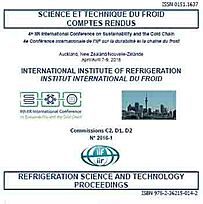
IIR document
State of the art: superchilling in the food processing industry.
Author(s) : BANTLE M., NORDTVEDT T. S., CLAUSSEN I. C., et al.
Summary
Controlled partial freezing or superchilling of food products can result in significant shelf life extensions during the cold chain. Between 10 % - 20 % of the foods water content is frozen and the ice functions as a thermal inertia during storage and transportation. Superchilled product have in general an extended shelf life and the technology shows good potential for implementation in the cold chain, since the product quality is comparable with refrigerated products. Superchilling in industry can also reduce the use of freezing/thawing for production buffers and thereby reduce labor, energy costs and product weight losses. Superchilled products sustain quality parameters commonly associated with fresh/unfrozen products. However some increase in product drip loss may occur during storage. Implementation of superchilling in industrial process plants and routines require a strict temperature control in the cold chain. Understanding and quantifying thermo-physical processes at and inside the food surface are important for the optimal design of superchilling equipment and packing systems for food products.
Available documents
Format PDF
Pages: 8
Available
Public price
20 €
Member price*
Free
* Best rate depending on membership category (see the detailed benefits of individual and corporate memberships).
Details
- Original title: State of the art: superchilling in the food processing industry.
- Record ID : 30017547
- Languages: English
- Source: 4th IIR International Conference on Sustainability and the Cold Chain. Proceedings: Auckland, New Zealand, April 7-9, 2016.
- Publication date: 2016/04/07
- DOI: http://dx.doi.org/10.18462/iir.iccc.2016.0001
Links
See other articles from the proceedings (63)
See the conference proceedings
Indexing
- Themes: Freezing of foodstuffs
- Keywords: Food industry; Cold chain; Review; Superchilling; Energy saving; Freezing time
-
Porównanie metod obliczania czasu zamrazania pr...
- Author(s) : KASIECZKA W.
- Date : 2008/10/15
- Languages : Polish
- Source: Projektowanie i eksploatacja przyjaznych srodowisku systemów chlodniczych i klimatyzacyjnych. Miedzynarodowa konferencja. XL Dni chlodnictwa.
- Formats : PDF
View record
-
La chaîne du froid des produits périssables, co...
- Author(s) : BILLIARD F.
- Date : 1992/09/07
- Languages : French
- Source: Proposals for the generation and use of refrigeration in the 21st century.
- Formats : PDF
View record
-
Non-conventional cold storage regime for food a...
- Author(s) : JUN S., LEE D., KANG T.
- Date : 2023/08/21
- Languages : English
- Source: Proceedings of the 26th IIR International Congress of Refrigeration: Paris , France, August 21-25, 2023.
- Formats : PDF
View record
-
A GENERALLY APPLICABLE SIMPLE METHOD FOR PREDIC...
- Author(s) : CLELAND D. J.
- Date : 1991/08/10
- Languages : English
- Source: New challenges in refrigeration. Proceedings of the XVIIIth International Congress of Refrigeration, August 10-17, 1991, Montreal, Quebec, Canada.
- Formats : PDF
View record
-
Freezing of packed semi-liquid foodstuffs.
- Author(s) : MICHNIEWICZ M.
- Date : 1995/08/20
- Languages : English
- Source: For a Better Quality of Life. 19th International Congress of Refrigeration.
- Formats : PDF
View record
